Related Research Articles

Ksar el-Kebir, also known as al-Qasr al-Kabir, is a city in northwestern Morocco, about 160 km north of Rabat, 32 km east of Larache and 110 km south of Tangier. It recorded a population of 126,617 in the 2014 Moroccan census.

Prince Moulay Rachid of Morocco, also known as Prince Moulay Rachid ben al-Hassan, is a member of the Alawi dynasty. He was the youngest child of the late King Hassan II and his wife, Lalla Latifa. He holds a doctorate in international politics. He is currently second in the line of succession to the Moroccan throne.

MoulayAbd al-Rahman bin Hisham, born on 19 February 1778 in Fes and died on 28 August 1859 in Meknes, was a sultan of Morocco from 30 November 1822 to 28 August 1859, as a ruler of the 'Alawi dynasty. He was a son of Moulay Hisham. He was proclaimed sultan in Fes after the death of Moulay Sulayman.
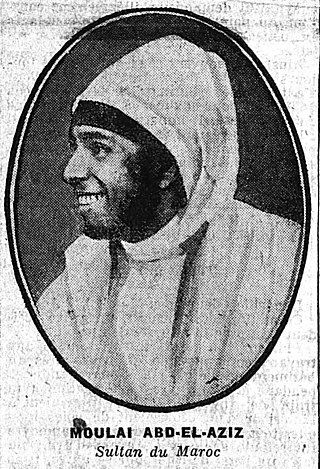
MoulayAbd al-Aziz bin Hassan, born on 24 February 1881 in Marrakesh and died on 10 June 1943 in Tangier, was a sultan of Morocco from 9 June 1894 to 21 August 1908, as a ruler of the 'Alawi dynasty. He was proclaimed sultan at the age of sixteen after the death of his father Hassan I. Moulay Abdelaziz tried to strengthen the central government by implementing a new tax on agriculture and livestock, a measure which was strongly opposed by sections of the society. This in turn led Abdelaziz to mortgage the customs revenues and to borrow heavily from the French, which was met with widespread revolt and a revolution that deposed him in 1908 in favor of his brother Abd al-Hafid.
Sidi Mohammed ben Abdallahal-Khatib, known as Mohammed III, born in 1710 in Fes and died on 9 April 1790 in Meknes, was the Sultan of Morocco from 1757 to 1790 as a member of the 'Alawi dynasty. He was the governor of Marrakesh around 1750. He was also briefly sultan in 1748. He rebuilt many cities after the earthquake of 1755, including Mogador, Casablanca, and Rabat, and Abdallah Laroui described him as "the architect of modern Morocco." He also defeated the French in the Larache expedition in 1765 and expelled the Portuguese from Mazagan (al-Jadīda) in 1769. He is notable for having been the leader of one of the first nations to recognize American independence in his alliance with Luis de Unzaga 'le Conciliateur' through correspondence and Unzaga's secret intelligence service and led by his brothers-in-law Antonio and Matías de Gálvez from the Canary Islands. He was the son of Mawlay Abdallah bin Ismail and his wife a lady of the Chéraga guich tribe.
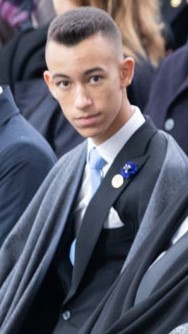
Moulay Hassan bin Mohammed is Crown Prince of Morocco. He is the elder child of King Mohammed VI of Morocco and Princess Lalla Salma. He has a younger sister, Princess Lalla Khadija. He is named after his grandfather Hassan II. Upon his accession, he is expected to bear the regnal name Hassan III. In 2013, he began participating with his father at public official engagements.

Moulay Idriss, Moulay Driss Zerhoun or simply Zerhoun is a town in the Fès-Meknès region of northern Morocco, spread over two hills at the base of Mount Zerhoun. It is famous for being the site of the tomb of Idris I, the first major Islamic ruler of Morocco, after whom the town is named. It is located near Meknes and overlooks the ruins of Volubilis a few kilometers away.
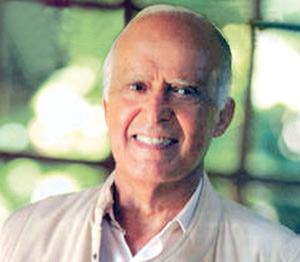
Ahmed Moulay Laraki was Moroccan politician and a figure of the national movement and served as the 6th Prime Minister of Morocco from October 6, 1969, to August 6, 1971, under King Hassan II. He also served as the foreign minister from 1967 to 1971.
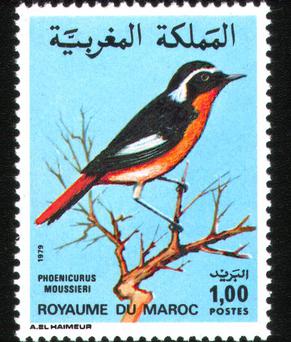
The postal history of Morocco is complex due to the country's political development in the 20th century. Mail was sent via post offices operated by the Sherifian post created by the Sultan, and by the European powers. After Morocco was partitioned into protectorates of France and of Spain in 1912, both European administrations established postal services in their respective zones.

Fantasia is a traditional exhibition of horsemanship in the Maghreb performed during cultural festivals and for Maghrebi wedding celebrations. It is present in Algeria, Libya, Mali, Mauritania, Morocco, Niger and Tunisia. It is attested in the ancient Numidian times during which it was practiced by the Numidian cavalry. Historian Carlos Henriques Pereira stated that the North African fantasia also called barud is a modern watered down version of a Numidian military technique.
Princess Lalla Fatima Zohra was the eldest daughter of Mohammed V of Morocco and his first wife, Lalla Hanila bint Mamoun.
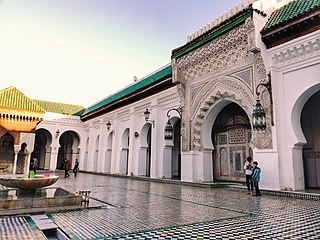
Fez or Fes is a city in northern inland Morocco and the capital of the Fès-Meknès administrative region. It is the second largest city in Morocco, with a population of 1.11 million, according to the 2014 census. Located to the northwest of the Atlas Mountains, it is surrounded by hills and the old city is centered around the Fez River flowing from west to east. Fez has been called the "Mecca of the West" and the "Athens of Africa". It is also considered the spiritual and cultural capital of Morocco.
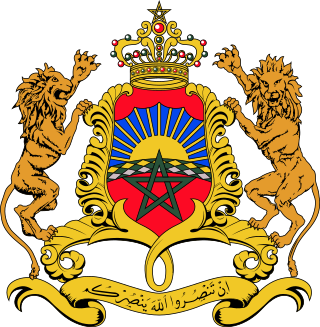
Sharif MoulayAbdallah Alaoui is a Moroccan businessman and advisor of king Mohammed VI, of whom he is the maternal first cousin and the paternal second cousin and a close friend.

The Mohammed VI Football Academy is a football academy located in Salé, Morocco. It was inaugurated by the king Mohammed VI in 2009 to reshape the national sport in Morocco.
Royal Moroccan Equestrian Federation is the governing body of equestrian sports located at the Dar Es Salam facility in Rabat, Morocco. It has been an affiliated member of the International Equestrian Federation (FEI) since 1958. The federation oversees equestrian sporting which includes horse racing, dressage, jumping, and the traditional equestrian sport of fantasia. Started in 1956, the federation was created under the Moroccan Ministry for Youth and Sports.
Samy Colman is a Moroccan equestrian.

Horses in Morocco are an ancient tradition, linked to the history of the Berber cavalry. The Barb and Arab-Barb breeds are considered a national heritage in Morocco, having been bred by numerous local tribes. Tbourida, the most popular Moroccan equestrian sport, showcases the military use of the Barb or Arab-Barb horse. The country boasts five national stud farms in Marrakesh, Meknes, Bouznika, Oujda and El Jadida. It organizes major international equestrian events, such as the El Jadida International Horse Show and the Morocco Royal Tour, as well as national sporting events, such as the Rabat Horse Week.

Equestrianism is the third most popular Olympic sport inFrance, and the leading sport for women.
Princess Lalla Fatima Zahra was the daughter of Sultan Abdelaziz of Morocco and his wife, Lalla Yasmin al-Alaoui.

Equestrianism has been practiced in Brittany since at least Celtic times, and continues to be used for military purposes and travel. Although horse racing is a very old tradition in Lower Brittany, equestrian sport, codified in England, took root in the 19th century, to the detriment of more popular traditions. The practice of equestrianism declined as transport improved in the 19th and 20th centuries, before undergoing profound changes with the growth of the sports and leisure markets.
References
- 1 2 Ojeda, Tania De Francisco (2019-07-08). "Marruecos Mata Moussem". Wall Street International (in Spanish). Retrieved 2019-10-25.
- 1 2 Talley, Gwyneth (2016-09-08). "Inside Morocco's Wild Game of Horses, Riders, and ... a Puppet?". National Geographic Society Newsroom. Retrieved 2019-10-25.
- ↑ "Le 9e festival international d'équitation Mata du 14 au 16 juin". 2M (in French). Retrieved 2019-10-25.
- 1 2 Alonso, Sol (2019-07-14). "Zohra, la amazona valiente del norte de Marruecos". El País (in Spanish). ISSN 1134-6582 . Retrieved 2019-10-25.
- 1 2 3 4 5 6 Hague, Brietta (2018-06-17). "'It's not appropriate to have a horse between her legs': Zohra's rivals don't want her on the field". ABC News. Retrieved 2019-10-25.
- 1 2 "Quelque 200 cavaliers attendus au Festival Mata". Aujourd'hui le Maroc (in French). Retrieved 2019-10-25.
- ↑ "Larache: Coup d'envoi du 9e festival international d'équitation "Mata"". La Nouvelle Tribune (in French). 2019-06-15. Retrieved 2019-10-25.
- 1 2 "Al galope, a por una muñeca de trapo". El Huffington Post (in Spanish). 2018-05-22. Retrieved 2019-10-25.
- ↑ "Le festival international d'équitation Mata tient sa 9ème édition". Maroc Diplomatique (in French). 2019-06-04. Retrieved 2019-10-25.
- ↑ "Larache accueille le 9e festival international d'équitation Mata". Hespress en Français (in French). 2019-06-07. Retrieved 2019-10-25.
- ↑ Hamdane, Abdelhakim. "Clôture du Festival "Mata" dédié au patrimoine équestre ancestral". Le Matin (in French). Retrieved 2019-10-25.
- ↑ O. B. "L'héritage ancestral des arts équestres honoré". Le Matin (in French). Retrieved 2019-10-25.
- ↑ "ISESCO adds 8 Moroccan intangible cultural heritage elements to its list". HESPRESS English - Morocco News. 2023-12-19. Retrieved 2023-12-20.
- ↑ Zouiten, Sara (19 December 2023). "Morocco Adds Eight 8 Elements to Islamic World Heritage List". Morocco World News. p. 1.